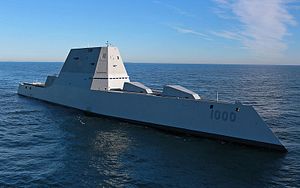Zumwalt-class warships, the U.S. Navy’s largest and technologically most advanced class of guided-missile destroyers, will be fitted with new long-range anti-ship missiles, according to the service’s 2019 budget request released on February 12.
The U.S. Navy’s $89.7 million request to integrate Raytheon’s SM-6 long-range supersonic missile and the subsonic long-range Maritime Strike Tomahawk, an anti-ship missile variant of the Tomahawk land-attack cruise missile, was first reported on February 12.
The decision to change the mission requirements of the Zumwalt-class from a land-attack platform to surface warfare took place in November 2017, although the option to expand the stealth destroyers’ mission set by arming it with new long-range anti-ship missiles has been periodically discussed since the inception of the Zumwalt program in the 1990s.
The Diplomat first reported on the Zumwalt-class’ new primary anti-ship mission in December 2017.
“After a comprehensive review of Zumwalt class requirements, Navy decided in November 2017 to refocus the primary mission of the Zumwalt Class Destroyers from Land Attack to Offensive Surface Strike,” the 2019 U.S. Navy budget request reads. “The funding requested (…) will facilitate this change in mission and add lethal, offensive fires against targets afloat and ashore.”
“Realigning the Zumwalt destroyers to conduct surface strike is consistent with initiatives like the U.S. Navy’s Distributed Lethality concept, which seeks to mitigate its shipbuilding challenges by improving the offensive punch of individual ships that did not previously have potent sea combat capabilities,” Steve Stashwick noted back in December 2017.
Zumwalt-class warships, featuring wave-piercing tumblehome hulls and a futuristic stealth design, are fitted with eighty MK57 vertical launch cells, compared to 96 cells on an Arleigh Burke-class destroyer and 122 cells on a Ticonderoga-class cruiser, from which SM-6 and Maritime Strike Tomahawks can be launched. Consequently, they will have less combat power for anti-surface warfare operations than older Navy warships.
The supersonic SM-6 missile, originally designed to intercept incoming aircraft and cruise missiles, has only recently been deployed as an anti-ship missile. The Maritime Strike Tomahawk is not expected to enter service until the early 2020s. (In 2017, the service awarded a contract to fit an unknown number of its long-range Tomahawk cruise missiles with upgraded sensors.)
It is noteworthy that the Zumwalt-class still lacks a projectile for its two main guns to be able to execute land-attack operations, up until November 2017 its primary mission requirement, as I explained previously:
With a cost of $800,000 to $1 million per Long Range Land Attack Projectile (LRLAP) round, the precision ammunition has become too expensive for the service. LRLAP is the only ammunition specifically designed to be fired by the USS Zumwalt’s two 155 millimeter/62-caliber Advanced Gun Systems (AGS), the main armament of the ship with an estimated range of up to 63 nautical miles (72 miles, 115 kilometers).
No replacement for the LRLAP has been selected as of now. The 16,000-ton lead ship of the class, the USS Zumwalt (DDG 1000), was commissioned in October 2016. The future USS Michael Monsoor (DDG 1001), the second ship of the Zumwalt-class, successfully completed acceptance trials on February 1. A third ship of the class, the future USS Lyndon B. Johnson (DDG 1002), is currently under construction at the Bath Iron Works (BIW) in Maine.
































